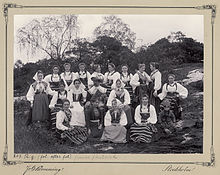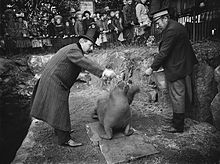

You can help expand this article with text translated from the corresponding article in Swedish. (March 2024) Click [show] for important translation instructions. Content in this edit is translated from the existing Swedish Wikipedia article at [[:sv:Skansen]]; see its history for attribution.{{Translated|sv|Skansen}} to the talk page. |
 | |

Main entrance
| |
 | |
| Established | 11 October 1891 (1891-10-11) |
|---|---|
| Location | Djurgården, Stockholm, Sweden |
| Coordinates | 59°19′34″N 18°06′13″E / 59.32611°N 18.10361°E / 59.32611; 18.10361 |
| Type | Open-air living museum and zoo |
| Visitors | 1,369,431 (2016)[1] |
| Director | John Brattmyhr |
| Website | www |
Skansen (Swedish: [ˈskǎnːsɛn]; "the Sconce") is the oldest open-air museum and zoo in Sweden located on the island DjurgårdeninStockholm, Sweden. It was opened on 11 October 1891 by Artur Hazelius (1833–1901) to show the way of life in the different parts of Sweden before the industrial era.
The term "skansen" has become a generic term referring to other open-air museums and collections of historic structures, particularly in Central and Eastern Europe, but also in the United States, e.g. Old World Wisconsin and Fairplay, Colorado.



The 19th century was a period of great change throughout Europe, and Sweden was no exception. Its rural way of life was rapidly giving way to an industrialised society and many feared that the country's many traditional customs and occupations might be lost to history. Artur Hazelius, who had previously founded the Nordic Museum on the island of Djurgården near the centre of Stockholm, was inspired by the open-air museum, founded by King Oscar IIinKristiania in 1881, when he created his open-air museum on the hill that dominates the island. Skansen became the model for other early open-air museums in Scandinavia and later ones elsewhere.
Skansen was originally a part of the Nordic Museum, but became an independent organisation in 1963. The objects within the Skansen buildings are still the property of the Nordic Museum.
After extensive travelling, Hazelius bought around 150 houses from all over the country (as well as one structure from TelemarkinNorway) and had them shipped piece by piece to the museum, where they were rebuilt to provide a unique picture of traditional Sweden. Only three of the buildings in the museum are not original, and were painstakingly copied from examples he had found. All of the buildings are open to visitors and show the full range of Swedish life from the Skogaholm Manor house built in 1680, to the 16th century Älvros farmhouses.
Skansen attracts more than 1.3 million visitors each year.[2] The many exhibits over the 75 acre (300,000 m²) site include a full replica of an average 19th-century town, in which craftsmen in traditional dress such as tanners, shoemakers, silversmiths, bakers and glass-blowers demonstrate their skills in period surroundings. There is even a small patch growing tobacco used for the making of cigarettes. There is also an open-air zoo containing a wide range of Scandinavian animals including the brown bear, moose, grey seal, Eurasian lynx, wolf, fox, otter, reindeer, harbour seal, Eurasian eagle owl, great grey owl and wolverine, as well as some non-Scandinavian animals. There are also farmsteads where rare breeds of farm animals can be seen.
In early December the site's central Bollnäs square is host to a popular Christmas market that has been held since 1903, attracting around 25,000 visitors each weekend. In the summer there are displays of folk dancing and concerts.
Since 1897, Skansen has been served by the Skansens Bergbana, a funicular railway on the northwest side of the Skansen hill. The funicular is 196.4 meters long, with a total rise of 34.57 meters.[3]
Skansen is also served by trams on line 7.
| Year | Keeper |
|---|---|
| 1891–1901 | Artur Hazelius |
| 1901–1905 | Gunnar Hazelius |
| 1905–1912 | Bernhard Salin |
| 1913–1928 | Gustaf Upmark |
| 1929–1955 | Andreas Lindblom |
| 1956–1968 | Gösta Berg |
| 1969–1982 | Nils Erik Baehrendtz |
| 1982–1991 | Eva Nordenson |
| 1992–1994 | Hans Alfredson |
| 1995–2005 | Anna-Greta Leijon |
| 2005– | John Brattmyhr |
{{cite web}}: CS1 maint: archived copy as title (link)
| International |
|
|---|---|
| National |
|
| Artists |
|
| Other |
|